
The coat of arms of British Columbia is the heraldic symbol representing the Canadian province of British Columbia. The arms contains symbols reflecting British Columbia's British heritage along with local symbols. At the upper part of the shield is the Union Jack, representing the United Kingdom. The lower portion of the shield features a golden sun setting into the ocean, representing the province's location on the Pacific.

The flag of British Columbia is based upon the shield of the provincial arms of British Columbia. At the top of the flag is a rendition of the Royal Union Flag, defaced in the centre by a crown, and with a setting sun, a view from parliament across the water at the province capitol, representing the location of the province of British Columbia at the western end of Canada.

The flag of the British Indian Ocean Territory (BIOT) is similar to the flags of other British dependencies and colonies as it has the Union Flag in the upper hoist-side corner. The palm tree and crown are symbols of the Indian Ocean Territory. The Flag was initially intended to be used by the Commissioner but has gained semi-official status as a territorial flag for use on land.

The flag of the Cayman Islands consists of a Blue Ensign defaced with the British overseas territory's coat of arms. Adopted in 1959 to supplement the Union Jack and to replace the flag of the Colony of Jamaica, it has been the flag of the Cayman Islands since the territory was granted self-government that year. The design of the present flag entailed removing the white disc and outlining the coat of arms with a white trim, although the previous version is often used in an official capacity. The Cayman Islands' flag is similar to the flags of eight other British Overseas Territories, which are also Blue Ensigns with their respective coats of arms.

The flag of the Gambia is the national flag of the Gambia. It consists of three horizontal red, blue and green bands separated by two thin white lines. Adopted in 1965 to replace the British Blue Ensign defaced with the arms of the Gambia Colony and Protectorate, it has been the flag of the Republic of the Gambia since the country gained independence that year. It remained unchanged throughout the Gambia's seven-year confederation with Senegal.
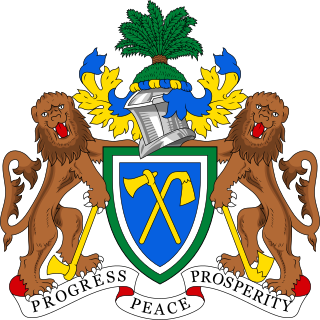
The coat of arms of the Gambia has been in use since 18 November 1964. It depicts two lions holding an axe and hoe, supporting a shield that depicts another pair of hoe and axe, crossed. Atop the shield is set the heraldic helmet and an oil palm as a crest. At the bottom is the national motto: Progress – Peace – Prosperity. The Gambian coat of arms also appeared in the fly of the Gambian air force ensign.

The original coat of arms of the Northwest Territories was granted by a Royal Warrant of Queen Elizabeth II on 24 February 1956. The shield is also featured on the territorial flag. The coat of arms was designed by well known Canadian heraldry expert Alan Beddoe in the early 1950s.

The coat of arms of Malaysia is a coat of arms comprising a shield or escutcheon, two tigers for supporters, a crescent and fourteen-pointed star for a crest and a motto. As the Malaysian coat of arms descended from that of the Federated Malay States under British colonial rule, it resembles European heraldic designs.
The Naval Crown was a gold crown surmounted with small replicas of the prows of ships. It was a Roman military award, given to the first man who boarded an enemy ship during a naval engagement.

The coat of arms of Malta is the national coat of arms of the country of Malta.

The Emblem of Iraq since the rule of Baathism features a golden black eagle looking towards the viewer's left dexter. The eagle is the Eagle of Saladin associated with 20th-century pan-Arabism, bearing a shield of the Iraqi flag, and holding a scroll below with the Arabic words جمهورية العراق.

The coat of arms of Fiji is the heraldic device consisting of a shield divided quarterly by Cross of St. George and charged with a gold lion at the top, supported by two Fijian warriors, one on each side, and topped with a canoe as the crest. Adopted in 1908 by a Royal Warrant, it has been the coat of arms of Fiji since that year, having been retained after independence in 1970. The escutcheon from the arms is featured on the flag of Fiji.

The coat of arms of Sierra Leone, were developed by the College of Arms and granted in 1960.
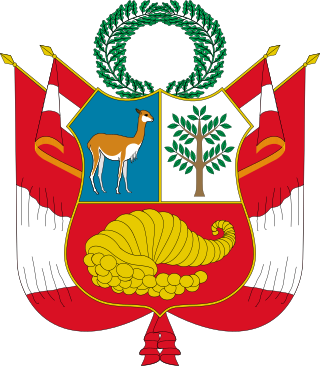
The Coat of arms of Peru is the national symbolic emblem of Peru. Four variants are used: the Coat of arms per se ; the National Coat of arms, or National Shield ; the Great Seal of the State ; and the Naval Coat of arms.
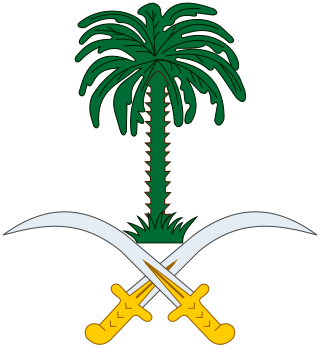
The Saudi Arabian national emblem was adopted in 1950. According to the Saudi Basic Law, it consists of two crossed swords with a palm tree in the space above and between the blades.

The national emblem of Sri Lanka is used by the State of Sri Lanka and the Sri Lankan government in connection with the administration and government of the country. The current emblem has been in use since 1972 and created under the ideas and guidance of Nissanka Wijeyeratne. At the time, he was Permanent Secretary to the Ministry of Cultural Affairs and Chairman of the National Emblem and Flag Design Committee. The designer of the emblem was Venerable Mapalagama Wipulasara Maha Thera, and the artwork was by S. M. Seneviratne.
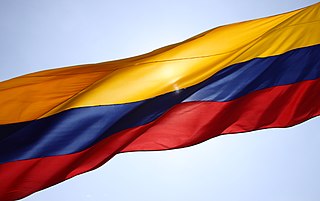
The National symbols of Colombia are the symbols which represent the national identity of the Republic of Colombia as a sovereign state. The national symbols intend to represent the Colombian identity by creating visual, verbal cultural iconic representations of the national people, values, goals, and history.
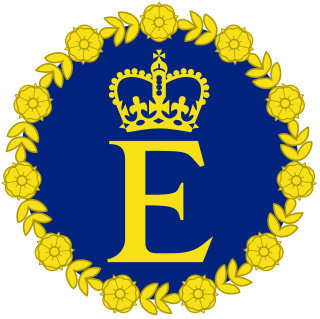
Queen Elizabeth II had a variety of flags to represent her personally and as head of state of several independent nations around the world. They were usually used on any building, ship, car, or aircraft where she was present.

Elizabeth II was Queen of Mauritius as well as its head of state from 1968 to 1992 when Mauritius was an independent sovereign state and a constitutional monarchy within the Commonwealth of Nations. She was also the monarch of other Commonwealth realms, including the United Kingdom. Her constitutional roles in Mauritius were delegated to a governor-general. Mauritius became a republic in 1992.



















